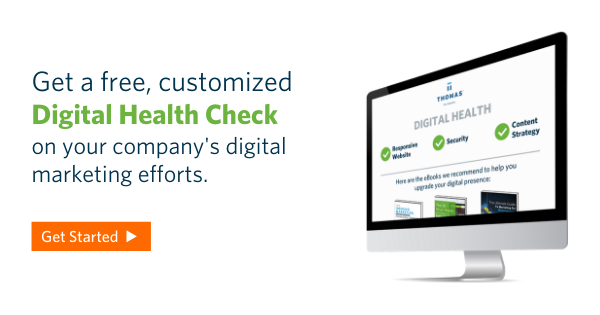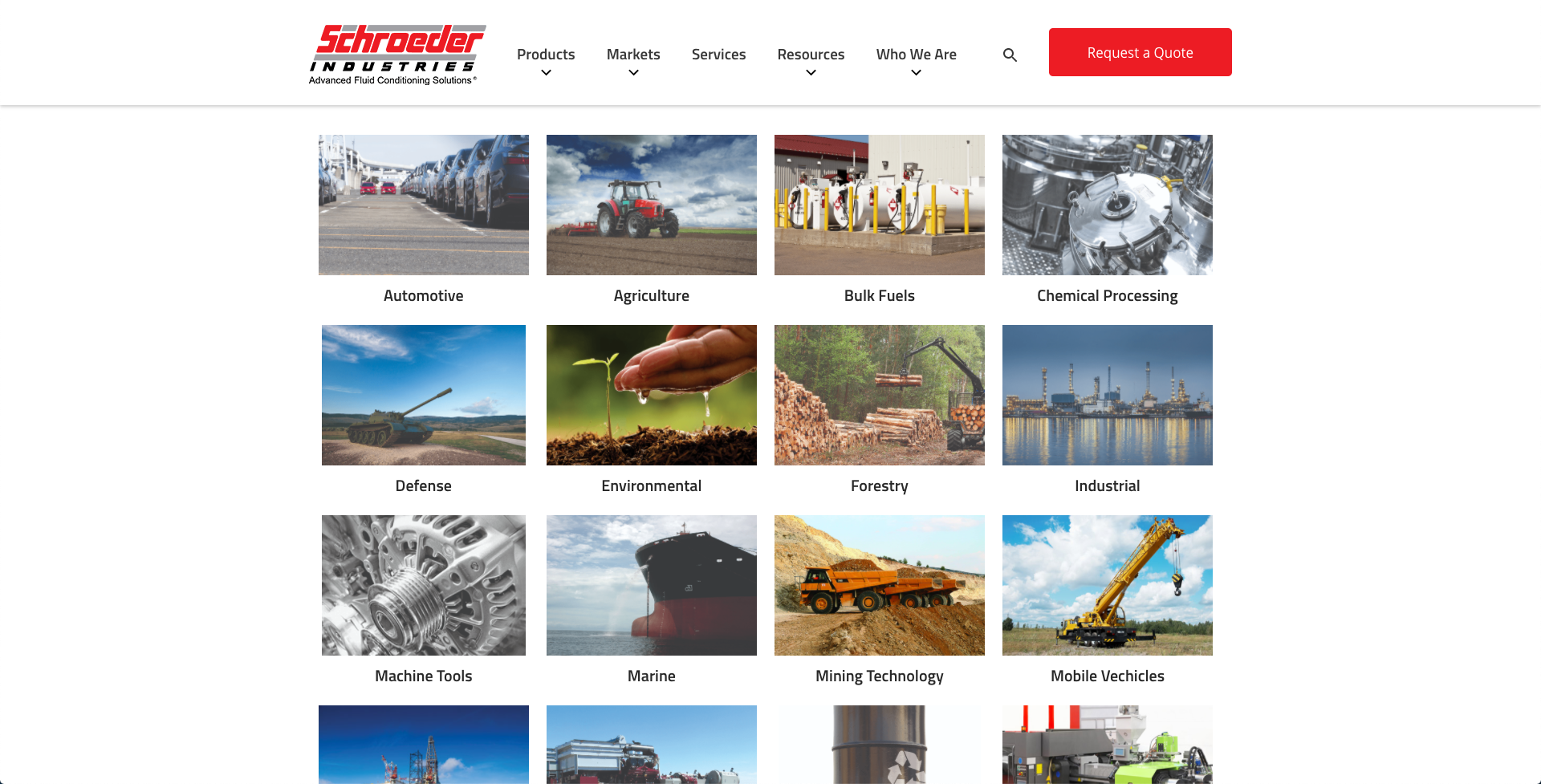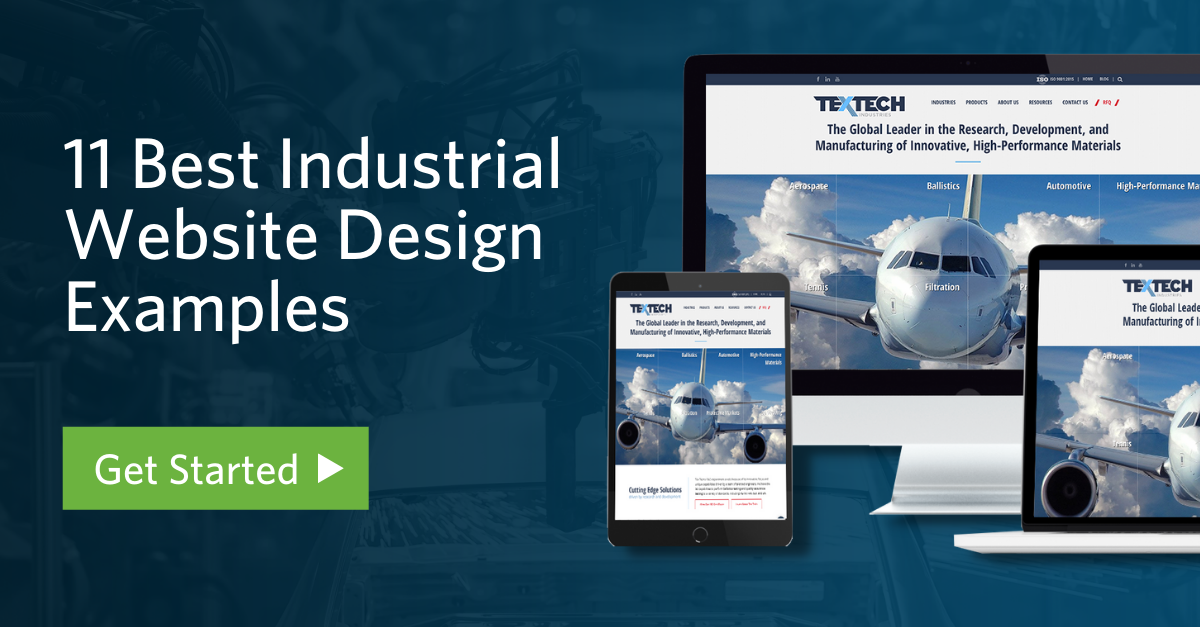Is There Value In A Manufacturer's Website In 2021?
Shalane Layugan October 5, 2021
If you're an OEM, industrial distributor, or custom manufacturer, these statements might sound pretty familiar:
- "We need to talk to prospects in order to qualify them."
- "Too much information on my site would give my competitors an advantage."
- "We get all of our new business from word-of-mouth."
- "A new website won't help me get new business because my current website doesn't, either."
If you're looking to grow your business, you may wonder why all the advice you find points you to something about website efforts. Well, that's because more of your buyers and competitors are doing business digitally. Supplementing your traditional growth methods with an updated website, online presence, and inbound marketing strategy helps out when cold calls and word-of-mouth fall short.
Is There Value In A Website For Manufacturers & Industrials?
In the 20th century, manufacturing was a roller coaster, with the majority of industrial companies coming out on top of their game. New clients rolled in with help from word-of-mouth referrals, direct mailings, and some online business directories. Then the internet spurned a period of intense, rapid change in the way businesses operate.
More prospective customers moved online, opening a floodgate of possible business opportunities — if you knew how to get found. With an increasingly large amount of data available on the internet in the past twenty years, buyers and purchasing managers began to turn there instead of in-person business acquaintances for supplier and product information.
So is there value in a website for manufacturers and industrial companies today?
Yes, if you're looking to connect with a new age of B2B buyers and get more qualified leads. A lead-generating website is a key priority for manufacturers and industrial companies who value getting more customers from the internet.
For example, E2Global, a provider of turnkey consumable manufacturing services, sought to expand its growth strategy beyond traditional in-person selling. The team understood that the key to success in today's world is to embrace digital efforts across their sales & marketing strategies.
“Our way of selling and our prospects’ style of buying was no longer aligning,” said Brad Godwin, CEO of E2Global. “Buyers want to be educated at their own pace and they don’t want to be immediately sold to, so we had to move from that.”
When presented with a cost-effective advertising & marketing solution that worked for E2Global 24/7, they decided to invest in expanding their reach. E2Global's new digital marketing efforts and new website received early results with RFQs from big brands like Medline and Colgate/Palmolive.
As the tail end of the millennial generation ages, graduates from college, and enters the workforce, these trends in internet usage continue to intensify. Millennials (roughly aged 20 to 36) in engineering and purchasing roles throughout the industrial industry rely on the internet, particularly search engines and Thomasnet.com, to find the information they need to make informed specifications and purchase decisions. Studies show that 73% of them use the supplier's website as a critical factor in submitting RFIs.
Do Manufacturers Really Need To Update Their Website?
But what if you already have a website? Can you just leave it as is? There are many good reasons to update and redesign your website — to make it mobile responsive, bring it in line with your current branding, or include more product technical data. But the most important overall goal of accomplishing all the above for businesses is to generate more leads.
So ask yourself this, "Do I want more business?"
If the answer is yes, then yes — you need to update your website.
➡️ Thomas Fact: Google also favors updated websites over those that don't get any maintenance for a few months, so your website will rank higher when you update it. To help you better understand how Google ranks your website, we break down some of the major components in our post How Manufacturers Can Maintain Healthy Website Traffic Following Google's New Algorithm Changes.
We can't reiterate it enough: Today's B2B buyers search for suppliers online, and they're not the same buyers from a few years ago. Today's B2B buyers are digital natives and expect content to be available on-demand, optimized for any device, interactive, and highly visual. They have higher expectations and are more informed, so their research is self-directed — which is expected when millennials are the largest workforce. And did you know that 73% of millennials are involved in B2B purchasing decisions?
According to our 2019 Industrial Buying Habits Survey, 80 percent of B2B buyers utilize search engines when sourcing new suppliers along with 71 percent of buyers who use Thomasnet.com. That's far more than word-of-mouth referrals (65 percent) and even internal company-preferred databases (41 percent).
Furthermore, when sourcing new suppliers, more buyers (73 percent) pay attention to a potential partner's
💡See if Fortune 1000 companies are searching for your industrial products and services with our Free Missed Opportunities Report
Buyers are researching you on your website. If it doesn't exist or reflects poorly on your company, they are likely to take their business to your competitors. Curious to see how your website compares against a competitor? Request a free digital health check and we'll review the performance of your website against a competitor and share tips for business growth.
"We tried other people with our website and marketing but found their focus wasn't on manufacturing, and Thomas is. We get a lot of activity now and steady results weekly — a lot of inquiries thanks to Thomas and our online marketing efforts," Ron Delfini, President at Engineering Specialties, Inc.
Before the digital transformation of industrial sales and marketing, businesses that simply had a website were already standing apart from the competition. You may have had, or currently have, a website that looks like this:
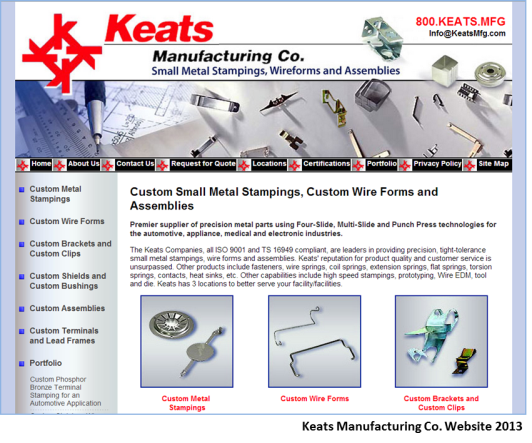
That was the standard back in 2013. But today, a site like that won't get the job done. Here are some signs your website is out of date:
- Not being able to view your website correctly on your phone
- Seeing "Not Secure" notification on your browser
- You haven't included new images of your latest products or facility
- You don't receive any leads from your website
Industrial buyers now require more information and quality content when researching services. The same website from Keats Manufacturing,
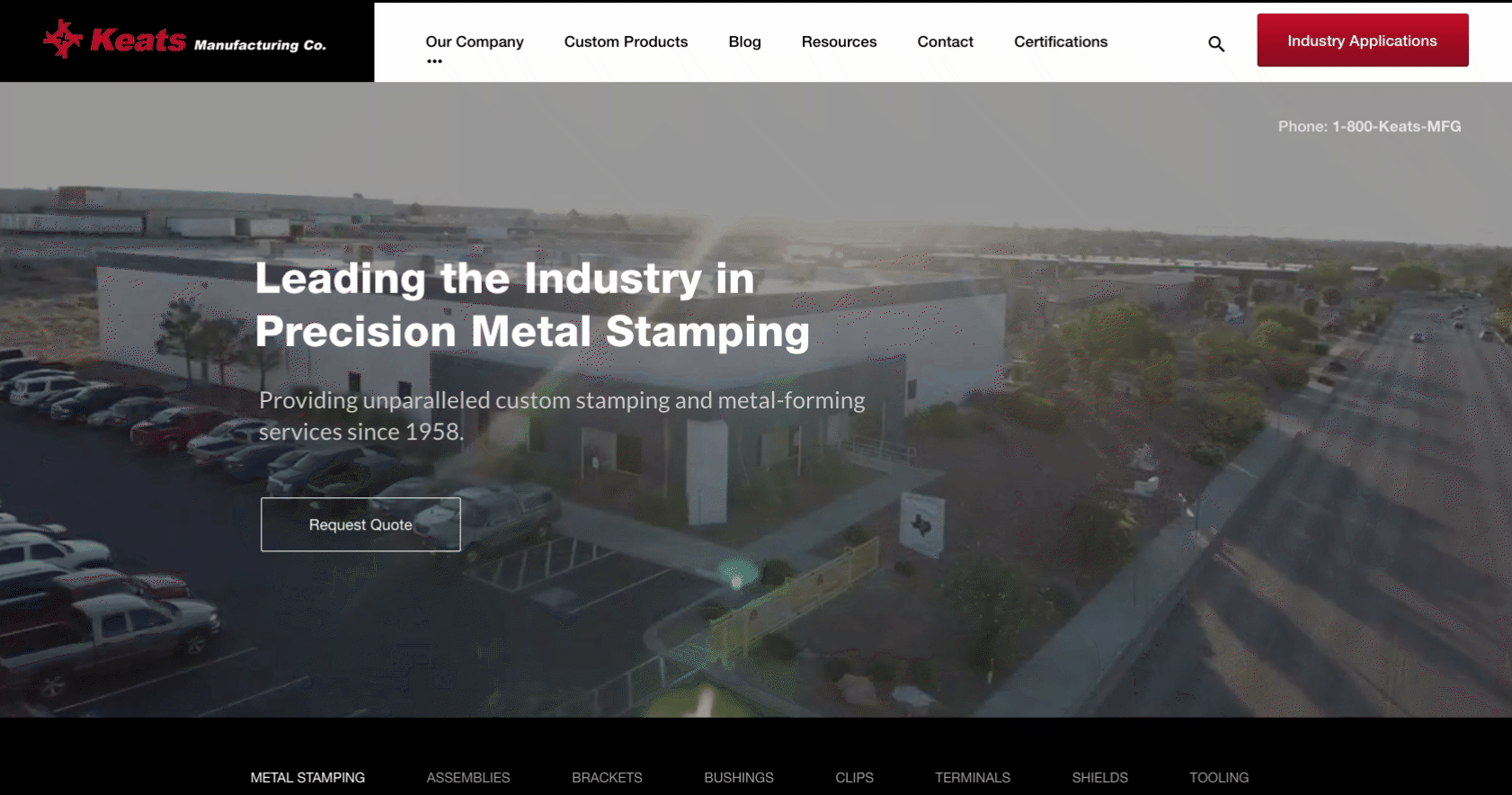
This updated website allows Keats to showcase many aspects of their business, including:
- Services and capabilities
- Company location
- Expertise
- Certifications
held - Current shop capacity
By communicating this information to Keats' buyers online, Keats can attract and convert targeted more customers.
What Are The Main Components Of A Website?
As your business grows, your website should be updated to reflect the changes in your company like new products, services, certifications etc. Designing your website will depend on the paths of your user (we'll touch more on understanding your buyer's persona later) but here are the main components your website navigation should start with:
Homepage
This is the first page that most people see. Consider a design that has navigation and CTAs people want to click on. Check out how Cyclonaire's navigation below makes it easy for users to find what they're looking for with the top menu of blue boxes and a Representative Locator, Customer Login, a Search function, and social media buttons in a contrasting color.
See more examples in 25 Website Must-Haves That Drive Leads & Sales
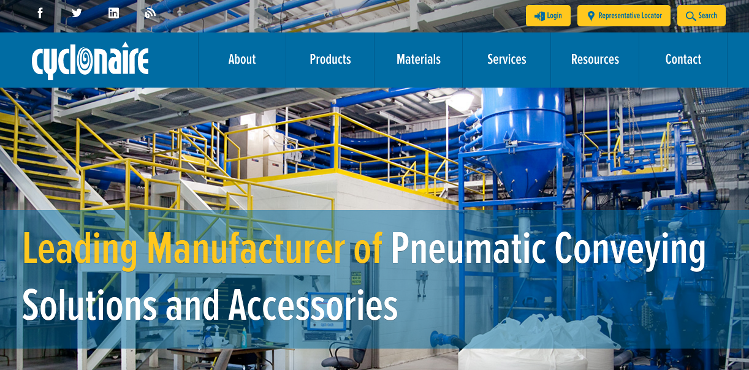
About Us page
Chances are, you already have an About Us page. But we've noticed manufacturers and industrial companies with About Us pages that are missing key information buyers are looking for, like ISO certifications and quality policies. Learn more: The Must-Haves For Your About Us page.
Product Pages
In today's industrial marketplace, sourcing professionals and engineers require digitized product catalogs to spec data and do their jobs. Customers need to be able to easily locate and engage with product data content and trust that it is accurate. By making online product data and eCommerce portals accurate and available, you increase your odds of getting shortlisted.
Your product data and your website need to work together to get you quality leads. With a digital toolset like Thomas Connect, OEMs and distributors' website upgrade is built with an eCatalog experience that solves data challenges and simultaneously drives sales.
ASC Engineered Solutions is a leading manufacturer & supplier of pipe connections, valves, support systems, and field services. To organize the product data on their own website, ASC decided to build an easily accessible, easily searchable product database. With functionality like product search and batch downloads, the team took an approach to help their customers complete their jobs quickly and with little friction.
“With BIM model downloads, it’s usually someone setting up a technical library and data repository on an internal server, forcing users to look at multiple product lines, product types, and sizes," said Suko Sulaimon, BIM & Digital Solutions Supervisor at ASC. "We don’t want this to be click or time-intensive. We give them what they need in a way that’s quickly accessible and this has really improved the digital customer experience and helped our company grow." [Read Their Full Case Study Here]
Blog Or Resources Page
A blog is an easy way to create content on an ongoing basis, solidify your credibility in the industry and increase SEO. Ensure you have a strong word count per blog — ideally 700 words or more.
Get Started:
While blogs are especially beneficial for search engine optimization and increasing organic traffic to your website, another easy layup that every industrial site should include is industry-specific pages. Industry pages help buyers understand the markets you serve and how best to help them with specific projects.
Schroeder Industries provides advanced fluid conditioning solutions to an array of different customers and it is clear on their website, they can help. On the Schroeder "Markets Page," all the industries this industrial company serves are listed from Automotive to Power Generation and everything in between.
Contact Us Page
You'd be surprised how many manufacturers and industrial companies miss out on the opportunity to add meaningful information on their Contact Us page. You need to list multiple options people can contact you — phone, address, email, and a form. Read more about a Contact Us page's best practices in this post.
How Do You Get More Leads From Your Website?
As you've already learned, optimizing your website for lead generation is not a set-it-and-forget-it task. There are a few quick fixes to get your website to increase clicks and engagement, but a complete website redesign requires a lot of careful planning. To keep things simple, we've listed out the first 10 steps you should focus on first.
1. Benchmark Your Current Metrics
Before you start thinking about anything, document your current performance metrics (if you have a website; if you don't have a website and have made it this far in our post, please give us a call). Start by analyzing your existing site over its history, including:
- Number of visits/visitors/unique visitors
- Bounce rate
- Time on site
- Current SEO rankings for important keywords
- Domain authority
- Number of new leads/form submissions
- The total amount of sales generated
If you don't have access to this information, we recommend adding a tool like Google Analytics for better tracking and visibility into site performance. You must be measuring the performance of your website from the start, and insight is everything for a marketer.

2. Determine Your Marketing Goals
Be really clear about why you’re upgrading and redesigning your site in the first place. Identify measurable, achievable outcomes, and then communicate your goals with your team, designer or agency. Many businesses focus on just getting more visitors or more page views, and although these are positive signs, the most important question you should be asking is "Does this traffic translate into more leads?" Every business is different — from a small machine shop to a larger enterprise — but it's important to choose goals that directly lead to your business' bottom line.
Remember that your website goals (and all your other marketing goals) should be "SMART" — the acronym for Specific, Measurable, Attainable, Relevant, and Timely.
With that in mind, consider the following goals for your website redesign:
- To increase the number of monthly qualified leads by 22% six months from website redesign launch
- To improve new service awareness by 10% by the end of the year
- To increase the website's conversion rate by 7% by the end of the quarter
- To increase website traffic by 50% in the next six months.
Many of these goals are dependent on each other. For example, to get more conversions, you need to increase traffic while decreasing the bounce rate.
Do you know which of your marketing channels are bringing in the most customers? A Marketing Automation tool like HubSpot lets you see your top-performing channels so you can make your marketing investments smarter.
- Social Media Measurement: Understand how social media is driving leads.
- Organic vs. Paid: See how much of your search traffic can be attributed to search engine optimization, and how much you’re paying for it.
- Buyers vs. Browsers: See which channels brought in serious leads versus website visitors who just came to look around.
3. Inventory Your Marketing Collateral Assets
While a redesign is a great way to improve results, there are countless ways it can hurt you. Your existing website contains many assets you have built up, and losing those during a redesign can damage your marketing. For instance, such assets might include:
- Most shared or viewed content
- Most trafficked pages
- Best performing keywords you rank for and associated pages
- Number of inbound links to individual pages
For example, if you remove a page with a higher number of inbound links, you could lose a lot of SEO credit, decreasing keyword rankings.
Keep in mind that many web designers don’t consider this step because they are not marketers. That's why it's important to work with an industrial team that understands all aspects of your business and is an expert in both website design and content marketing and your manufacturing industry. Read more on your options: Train In-House Or Hire An Agency, Freelancer?
4. Analyze The Competition In Your Industry
While we don’t recommend obsessing over your competitors, it helps to know how you stack up.
- Get a Digital Health Check to get a report card on how your website and marketing perform today.
- Research your competitors so you are aware of their strengths and weaknesses.
- Take a look at their websites, note what you like and what you don’t. BUT, this is not meant to copy them. That’s the last thing you want to do. Instead, you’ll uncover what you can do better.
HubSpot also makes it easy to set goals and see where you stand on traffic, inbound links, conversion rates, lead generation and other important metrics. Once you run the analysis, put together an action list of what areas you can improve and do differently from your competitors.
5. Identify Your Unique Selling Proposition
Before crafting your content, be clear about your Unique Selling Proposition (USP) to be consistent across your entire website. If you attract a high number of unique visitors, or you’re a new business, your visitors might not be very familiar with you and what you do. You need to demonstrate that what you do is right for them, and why they should stay on your website and buy from you.
Not creating a unique selling proposition is one of the most common mistakes we see manufacturers and industrial companies make.

6. Create Buyer Personas
Your website is not just about you. Your visitors ask, “What’s in it for me?” Speak to them in their language by creating content specifically for your buyer personas.
A buyer persona is when you slice your marketplace into individual groups of people. They are fictional representations of your ideal customers, based on real data about customer demographics and online behavior, along with educated speculation about their personal histories, motivations, and concerns.
Here's how you can begin to create buyer personas and utilize persona targeting effectively:
- Segment by Demographics: Start developing personas by researching your existing customer base to identify the most common buyers of your products and services. You may have several different types of buyers, so give each one a detailed description, including a name, job title or role, industry or company info, and demographic info.
-
Identify Their Needs: What are the biggest problems they are trying to solve? What do they need most? What information are they typically searching for? What trends are influencing their business or personal success?
-
Develop Behavior-Based Profiles: What do they do online? Are they active on Twitter, Facebook, or other social networks? What kind of search terms do they use? What kind of information do they tend to consume online? Which of your products do they spend the most time researching? How do they use those products?
Use your website to match your message to the needs of different buyer personas. Build your pages into categories to fit these personas, or offer content so that your prospects can easily find what’s relevant for them.
To learn more about the companies or individuals searching for your products and services right now, request a free In-Market Buyer Report.
"Thomas simply delivers the purest industrial audience on the internet, and being there has helped us connect with new customers in new industries.”
7. Implement An SEO Strategy
Getting found online is essential to improving the rest of your site metrics. If no one is coming to your site, how can you increase leads, downloads, or sales?
SEO stands for search engine optimization and implementing an SEO strategy helps bring more targeted buyers to your website. Here are some tips for increasing your website traffic:
- Document Your Most Search-Valued Pages: As mentioned in step three, know what pages have the strongest SEO juice, the most traffic, inbound links, and keywords rankings. If you plan to move highly ranked pages, create proper 301 redirects to not lose any of that value.
- Create A 301 Redirect Strategy: This may be THE most important step in retaining traffic and rankings. Simply create a spreadsheet to record and map out your 301 redirects. You may also have heard or seen 404-page errors. Check out how they relate to a 301 redirect in our blog, What Does A 404 Error Mean?
- Do Your Keyword Research: For every page, pick one to two keywords that the page will focus on. Once you determine the keyword(s), use on-page SEO tactics, such as internal link building and optimizing your header tags (H1, H2, H3, etc.)
Learn more about SEO with the eBook How To Increase Your SEO Traffic In Just 30 Days
8. Identify Calls-To-Action
Calls-to-actions are the elements on your website that drive visitors to take action, whether it’s a whitepaper download, contacting sales, or product purchase. Your website shouldn’t be a static brochure but should prompt your visitors to do something that further engages them with your brand.
When you’re planning for the redesign, think about all the potential opportunities for conversion. For example:
- Ebooks and whitepapers
- Contests and promotions
- Product purchases
- Email newsletter subscription
- Free trial
- Contact us / consultation / demonstration / etc.
While the “design” of your website is important, focus on functionality. Make sure there are plenty of calls-to-actions so you don’t lose visitors and check out 32 Industrial Lead Generation Tips, Tricks, and Ideas to see how to put your CTAs in action and here are some suggestions on how to get started with content marketing.

9. Create An Ongoing Content Strategy
If you have more content, on average you will have more website visitors and grow your business faster. A 100-page website will beat a 10-page website 99% of the time. And a 500-page website is even better, especially when it includes a constant flow of fresh content. Develop a content marketing strategy and continue to add more and more material to your website over time.
Here are additional references to make sure you're creating the right content that converts leads:
- The 10 Types Of Emails You Should Be Sending
- How To Create A Lead Generating eBook
- 11 Content Marketing Ideas For Manufacturers
“One of the underlying themes, as well as obligations, to market in our B2B ecosystem is to share our expertise,” said Jason Kline, Director of Marketing at Consolidated Electronic Wire & Cable. He stressed the marketing strategy isn’t just about branding at Consolidated, but rather engaging with customers and prospects with useful approaches to content.
“Our partners at Thomas help us to develop meaningful content that can aid folks through the buying process in our industry, and it has also helped grow our business. Whether you’re a first-year procurement manager or a twenty-five-year engineer, we’ve got direction to help you make educated decisions.”
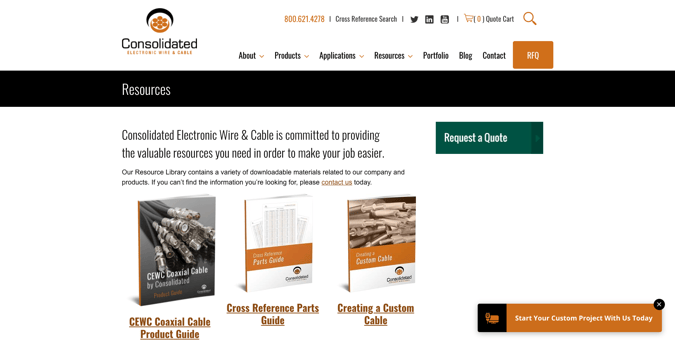
10. Choose A Strong Content Management System
You can update endless things on your website, but what's crucial is the foundation of your website — the content management system (CMS). Don't worry, using a CMS doesn't have to be daunting. Many small businesses create their first website using Wix. It's an easy drag-and-drop website builder, but as their business grows more web pages need to get created.
That's why we recommend using WordPress for your industrial site — 30% of all websites are powered by it! WordPress offers plugins for testimonials, a powerful selling tool, and it's mobile-friendly — a must to provide an optimal user experience for your leads and your growing business.
Related Info: WordPress vs. Wix, What's The Best Platform To Use For Manufacturers?
11. Promote Your Website Content
Once you've created all your online assets like blog posts, website pages, product catalogs, etc. it's time for the promotion phase. It's imperative to have all this collateral on your industrial website, but what's the point if you don't drive buyers to it?
Here are a few ways to drive traffic to your website and promote the products and services you offer:
- Email Marketing: Sending a weekly newsletter to your existing contacts list can nurture leads and increase engagement.
- Newsletter Advertising: Perhaps you don't have a strong list of quality contacts to email every week. Utilize the powerful audience of the Thomas Industry Update Newsletter. By placing an ad in this industrial newsletter, you can reach 300,000+ industrial decision-makers.
- Social Media: Schedule social posts across platforms like Facebook, LinkedIn, and Twitter to engage with existing and new contacts.
- Paid Marketing: Utilize pay-per-click or display advertising opportunities on search engines and social media to target a specific audience based on criteria like demographics, locations, and interests.
💡Thomas Tip: Did you know that you can increase your audience reach with Display Advertising on the Thomas Network? Reach industrial buyers like MROs, engineers, and procurement professionals where they're already sourcing for your services.
“We wanted to make more buyers and decision-makers aware of what we have to offer," said Mark T., of Toagosei America. "The team at Thomas explained the benefits of advertising in the Thomas Industry Update and it ended up being a great way to help us generate that awareness. We earned new contacts for our sales team to call on!”
More Best Website Examples For Inspiration
Any website built today should include these basics: a homepage, product pages, industry resources, and a Contact Us/About Us pages. But there’s more to the basics that can really make your website awesome, including:
- Landing Pages: Landing pages with calls-to-action are critical lead generation components. Create awesome landing pages as part of the redesign for your offers and assets, like whitepapers and guides.
- RSS Subscription: RSS allows some content from your website to be automatically pushed out to other websites and people, increasing the reach of your content.
- Social media icons: Add social media sharing buttons/links to all your pages so your readers can share your expertise to their networks. You can use tools like ShareThis or AddThis.
Check out 25 Website Must-Haves That Drive Leads and Sales for more website examples and best website designs from manufacturers and industrial companies.
And remember, a website is not a silo. Its integration with other functions, such as social media and email marketing is critical. There's still a lot more work involved in keeping your marketing strategies aligned, optimizing your website, and reporting on the results (yes, the work doesn't end!) so if you need a partner to help out, get in touch with our team. Thomas offers a free digital health check to see what exactly you need on your website to engage with more prospects and win more business.
"Partnering with Thomas has been a tremendous success," said an executive at Conformance Coatings & Prototyping. "We are seeing 1-3 inquiries a week now and are working on expanding our supply base to support the new opportunities."
You Might Also Be Interested In:
Did you find this useful?





